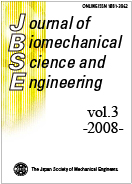Volume 3, Issue 4
Special Issue on Biomechanics and Dynamics of the Biomaterials under Impact and Vibration
Displaying 1-8 of 8 articles from this issue
- |<
- <
- 1
- >
- >|
Special Issue on Biomechanics and Dynamics of the Biomaterials under Impact and Vibration
-
2008Volume 3Issue 4 Pages 452
Published: 2008
Released on J-STAGE: October 10, 2008
Download PDF (133K)
Papers(Special Issue)
-
2008Volume 3Issue 4 Pages 453-460
Published: 2008
Released on J-STAGE: October 10, 2008
Download PDF (765K) -
2008Volume 3Issue 4 Pages 461-467
Published: 2008
Released on J-STAGE: October 10, 2008
Download PDF (312K) -
2008Volume 3Issue 4 Pages 468-477
Published: 2008
Released on J-STAGE: October 10, 2008
Download PDF (696K) -
2008Volume 3Issue 4 Pages 478-489
Published: 2008
Released on J-STAGE: October 10, 2008
Download PDF (950K) -
2008Volume 3Issue 4 Pages 490-498
Published: 2008
Released on J-STAGE: October 10, 2008
Download PDF (541K) -
2008Volume 3Issue 4 Pages 499-509
Published: 2008
Released on J-STAGE: October 10, 2008
Download PDF (1211K)
Papers
-
2008Volume 3Issue 4 Pages 510-519
Published: 2008
Released on J-STAGE: October 30, 2008
Download PDF (1608K)
- |<
- <
- 1
- >
- >|
